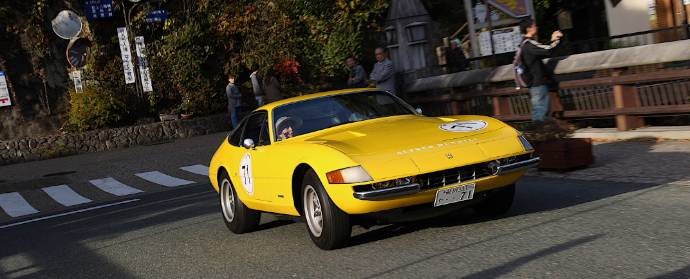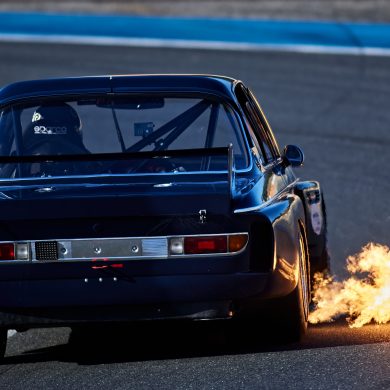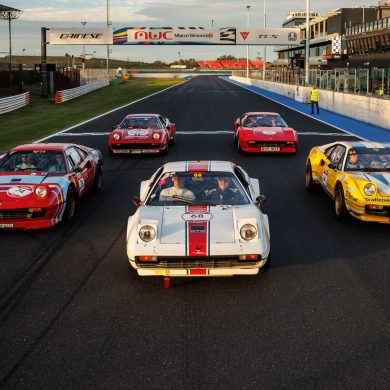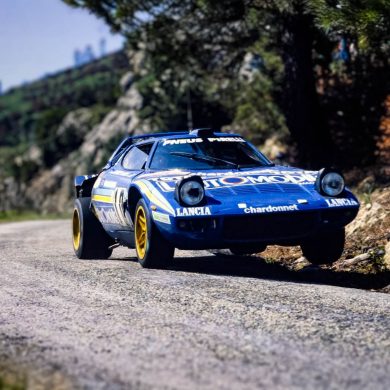Report and photos by Len Clarke
Rally Nippon had its fourth running over November 3-6, 2012, this year’s route taking the more than 80 classic cars through eight of the nation’s 47 prefectures as it wended its way from Kyoto to Tokyo over a demanding and fast-paced four-day schedule covering nearly eleven hundred kilometres (675 miles).
By far the youngest event on the historic rallying calendar here, Rally Nippon has quickly gained as much notoriety for the quality of entrants on its roster as for the places on its itinerary.
Making a point of including sites that are not only aesthetically pleasing, but also important culturally is one of the many attributes that sets it apart. It is possibly because of this cultural acknowledgement that the number of foreign entrants has grown year-on-year. Organiser Yusuke Kobayashi is emphatic when he explains, “Our aim is to show the beauty, the history and the cultural importance of some of Japan’s most revered sites.” Many places on the agenda are indeed designated World Heritage sites – and it’s easy to see why.
Jump to Rally Nippon Photo Gallery
The rally got underway on a sun-drenched Saturday morning at Kamigamo Shrine, the oldest of its kind in Japan’s ancient capital, Kyoto. The remarkably picturesque city is renowned for its lack of modern, tall buildings and is instead festooned with temples, shrines and all manner of historic structures, which at least partly explains the daunting number of foreign visitors I saw wandering its streets as the cars set off.
From the start point, it was a relatively short jaunt to Tofuku-Ji Temple, one of the five great Zen temples of Kyoto, and familiar to anyone who’s seen a tourist brochure of the city. The afternoon’s stages then saw the cars kick into high gear as they sped into Shiga prefecture and the quaint Omi Hachiman temple complex, where competitors were treated to a short boat ride after visiting the main temple buildings.

The second day’s 337-km route traversed two more prefectures, Fukui and Gifu, taking in the ruins of the Ichijodani Asakura clan on its way to the pretty hamlet of Gujo Hachiman, located at the geographic centre of the country. The leg ended with a drive at dusk through the historic Udatsu (wooden shutter)-lined streets of Mino.
Monday saw the greatest distance covered in any one day, slightly over 400kms. The weather up to this point had cooperated beautifully, and as the competitors snaked out of Gifu and into Nagano and then Yamanashi prefectures, the sun shone without interruption. Chief among the day’s many attractions was Suwa Grand Shrine, where celebrity gagaku (ancient Japanese court music) player and former member of Japan’s Imperial Household Agency’s music department Hideki Togi gave a resounding performance to the rest of the competitors. Togi was joined on stage by his 81-year old mother, who was also competing on the rally. The leg ended in Hakone, one of the most exclusive (and achingly beautiful) of the country’s getaway spots, despite the onset of heavy rain, which made visibility difficult at times.
Jump to Rally Nippon Photo Gallery
The final day started with no let-up in the weather, and one had to feel a little sorry for the many entrants in open-top cars, which, just like their occupants, were getting thoroughly soaked. Tsurugaoka Hachiman-Gu Shrine is one of the largest and most important in Kamakura, a city that, over a thousand years ago, ruled this region. Although by now sodden, the entrants braved the elements as they trudged through the narrow streets on their way to check points before heading out onto the open road for the last blast, one that would take them all the way up to Tokyo.
Once in the capital, competitors headed straight for Yasukuni Grand Shrine, one of the nation’s most famous sites of worship. The rain did let up briefly as the first of the cars streamed in, though as the afternoon wore on, things became fully wet once more.

Japan is a country of extremes: extreme beauty, extreme history and architecture, extreme weather, and in this case, an extreme(ly enjoyable) challenge. The schedule was relentless; it was by no means a recreational rally. The competitors are just that, competitors – and they’re very serious about winning!
The 2013 Rally Nippon will venture further afield, with “Rally Nippon in Taiwan” taking in a complete lap of the island. Kobayashi-san relates, “We are most excited to have been given the green light to hold an event in Taiwan, and for a number of reasons. First, Japan is culturally and historically very close to Taiwan, and more recently, Taiwan’s citizens contributed vast amounts of support to Japan after last year’s earthquake and tsunami. We wish to offer our sincere thanks to the people of Taiwan, and see the rally was a way of strengthening ties between our two peoples.” Looking longer term, Kobayashi-san hopes to expand to other parts of Asia, with Singapore and Malaysia top of his list for future events.
Jump to Rally Nippon Photo Gallery
Rally Nippon 2012 – Photo Gallery
(click image for larger picture and description)
[nggallery id=505 images=15]
[Source: Len Clarke]











Really nice and interesting set of cars. Love the Ermini. Want.